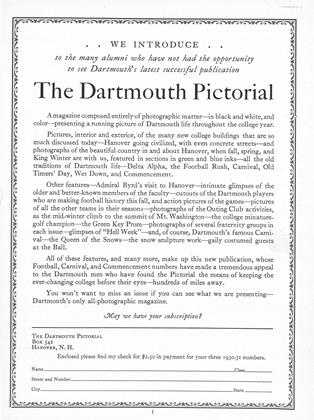By John Anderson & Stearns Morse. Minton, Balch & Company, New York, 1930.
This volume deals with the White Mountains for the benefit of tourists who wish to learn their way about, to make the more familiar climbs, to know something of the history and traditions and characteristics of the region. In addition it quotes at length, with irreverent comment, from its predecessors, an unusual idea which adds much to its bulk and more to its readability. As a guide and reference book for the casual visitor it seems to me admirably done. Probably I was asked to review it because of my long acquaintance with these mountains, and keen interest in everything written about them, which was risky, for the enthusiast is hard to please. But I like this book, and better on second glance. I have not looked for small errors—none stared at me—and, knowing one of the authors fairly well, I doubt if they are there in more than the permitted quantity. To be sure the end-paper map has some oddities, including a new mountain erupted and named overnight, a couple of names dead these ten or twenty years, and some roads which ought to exist, but don't —but it is a sketchy thing anyway. Evidently great pains were taken with the illustrations. They are half-tones mostly from commercial photographs. Within those limitations they are exceptionally good.
It seems to be the literary fashion of the moment to conceal the emotions, to understate, to avoid straining toward expression of the inexpressible. So in this book the authors are very restrained, very shy of adjectives. Their very real love of these mountains finds its escape from repression in gay flings at the turgid eloquence of their Victorian predecessors. Very out-moded are these old books from which they quote at much length, and so appositely. But I belong to a generation between, and to me Starr King and the rest seem more dull than ridiculous, and Anderson and Morse, sometimes, a bit too flippant. Which, perhaps, merely dates and damns the reviewer. And the authors make their apology very handsomely at the end—"ave atque vale for . . . that gallant company of our predecessors. . . . We have not always treated them and their lucubrations altogether reverently, not even the mountains themselves as reverently as they would have wished us to But other times, other customs."
"The Book of the White Mountains" they call it. One who loves the mountains can only smile, and hope that he may be spared to see the real thing. Meanwhile, in the sense the publishers intend, this is "the" book. It is up-to-date and sufficiently inclusive, has the essential information, is seldom dull (a real achievement in a book of this type). For its purpose as stated at the beginning of this review it seems entirely adequate and heartily to be recommended.
 View Full Issue
View Full Issue
More From This Issue
-
 Article
ArticleThe Class of 1934
November 1930 By Charles R. Lingley -
 Class Notes
Class NotesCLASS OF 1930
November 1930 By Albert I. Dickerson -
 Lettter from the Editor
Lettter from the EditorEditorial Comment
November 1930 -
 Class Notes
Class NotesCLASS OF 1913
November 1930 By Warde Wilkins -
 Class Notes
Class NotesCLASS OF 1920
November 1930 By Allan M. Cate -
 Article
ArticleA Course in the Department of Biography
November 1930 By Harold E. B. Speight
N. L. Goodrich
Books
-
 Books
BooksLittle Theater Organization and Management
MAY 1927 -
 Books
BooksShelflife
July/August 2007 -
 Books
BooksTHE NEW VETERAN
January 1946 By Arthur E. Jensen -
 Books
BooksPOLLUTION, PROFITS & PROGRESS.
JANUARY 1972 By CHARLES KERSHNER -
 Books
BooksA MODERN CONQUISTADOR. ROBERT BONTINE CUNNIN GHAME GRAHAM
February 1933 By John Hurd Jr -
 Books
BooksSKIING FUNDAMENTALS, EQUIPMENT, AND ADVANCED TECHNIQUE
February 1937 By Nathaniel L. Goodrich




